Introduction
Description
The objective of our call center is to accomplish a future expansion for four locations Dallas, Denver, Chicago Headquarters, and Atlanta, and part of the programs we aim to accomplish are to offer new products to customers such as credit card protection and registration. The plan program we intend to initiate is to enhance the capabilities of customer’s support center to support 50 employees and 20 mobile users with wireless access. Typically, the strategies to achieve the management policies are to install WAN for the connection of all four sites and to offer 24 hours operations across all sites. More requirements we aim to achieve are to install database that will offer 24 hours operations to all sites, deployment of a wireless network at each site, VoIP at each site, and monitoring control that is redundant. Decision to use WAN to connect all four centers is a step forward for the enhancement of competitive advantage, and apart from increasing the speed at which management take decisions on strategic issues, integration of WAN also enhances quality of service (QoS), and this increase overall customer’s satisfactions. (Murhammer et al, 1999).
However, achieving best network performances for Call center requires systematic network planning and design, and there are procedures to take before designing WAN that will suit management aims. Offering effectively networks design that would serve Chicago, Denver, Atlanta, and Dallas need an identification of specific network design and management issue.
Identification of Specific Network Design and Management Issues
The major objective we aim to accomplish with our call center design would be to install scalable and high performance Local Area Network’s (LAN) and a Wide Area Network (WAN) that will support 50 employees and 20 mobile users with wireless access at each of the call centers The requirements we propose for this expansion will include establishment of a WAN that connects Dallas, Denver, Chicago, and Atlanta with redundancy to support 24/7 365. We also the need to install database for Call center, which offers data storage, and data security for customers. The major objectives for the installation of database for all four locations are to store customer’s data, as well as to offer security for customers’ credit cards. In addition, we aim to offer protection of customer’s credit cards, and customers’ information by installing adequate security for overall system design. To ensure that our call center meets all the requirements of network design, we propose the following budget:
- Wide Area Network connection across Dallas, Denver, Chicago, and Atlanta $800,000
- LAN network infrastructures for Dallas, Denver, Chicago, and Atlanta $4,000,000
- Other miscellaneous costs
Thus, to achieve our objectives for network system, we consider the following implementation plans:
- Recommendation of WAN architecture for Dallas, Atlanta, Denver, and Chicago Headquarter.
- Recommendation of telecommunications links across Dallas, Atlanta, Denver, and Chicago Headquarter.
- System design for database that will support the 24/7 365 day operations for Dallas, Atlanta, Denver, and Chicago Headquarter.
- Recommendation of design for video conferencing.
- Analysis and planning of the voice network.
- System back up recovery.
- Network security plan.
- Desktop anti-virus plan.
- High level Project Plan.
To provide adequate picture of network design we aim to accomplish, it is essential to provide background of overall system requirements.
Background
Our strategy to achieve LAN for all four locations and WAN to link across our four locations require some protocols we need to follow to achieve our requirements for network systems for Dallas, Denver, Chicago, and Atlanta. Our needs for efficient communication across all our Call centers necessitate integration of WAN technology to facilitate data communication across all the four locations. (Cisco, 2009). As Stair, and Reynolds, (2007) put it “in today’s high-speed business world, effective communication is critical to organizational success,…what separates good management from poor management is the ability to identify problems and solve them with available resources.”. (p 136).
Thus, our decision to install WAN for connection across all our call centers has several benefits. The benefits we aim to accomplish of WAN are best described by Stair, and Reynolds, who state that “the combination of wireless network and IP phones enhance ability to access any information, including database reports from the corporate database server, e-mail, and the Web, and communicate with colleagues one at a time or in groups through voice or video from any location” (p 136).
Added to WAN, we propose to install each of the four locations LAN that offers high scalable considerable bandwidth capacity because of our business expansion. The proposed LAN will also be able to have high reliability, and be able to offer interface with Wide Area Network.
Typically, our four call centers will achieve the following benefits from proposed networks design.
- Enhancement of corporate strategic advantages.
- State-of-the-art operation centers for Dallas, Denver, Chicago, and Atlanta.
- Provision of latest network support for four locations.
- Provision of database system for four locations.
- High-speed connectivity across Dallas, Denver, Chicago, and Atlanta.
- VoIP at each site for management to monitor control that is redundant.
- Scalable Local Area Networks.
- Reliable of High network.
- Flawless LAN to WAN interfaces.
- A secure network with firewalls at the internet and extranet levels.
- Anti-Virus software at the desktop and server levels.
- Disaster recovery planning for all network and server components.
Problem statement
The expansion plan of our call center will involve protection of customers’ credit cards and customers’ registration. However, our call center does not have the latest technology to offer protection for customers’ credit cards. In addition, existing technology of our call center cannot support VoIP and data at our four call center’s (Dallas, Denver, Chicago Headquarters, and Atlanta). Moreover, there is no latest technology for a database to support all four locations 24/7 365 day operations. Thus, our Call center requires a WAN to connect all four sites with redundancy to support 24/7 365-day environment, and a database that will support the locations for 24/7. Our call centers will need these to enhance business agility and improvement of effective communication among employees in the four locations (Hekmat, 2007). Typically, effective network topology that can satisfy management’s needs is Wide Area Network., and implementation of WAN in the four locations will enhance transmission of information and improvement of organizational efficiency and effectiveness. WAN network is advantageous to share hardware, programs, and database across our four locations and with implementation of WAN network, our call centers will be able to share documents over wide geographical areas. This will also foster teamwork among our employees and enhancement of business strategies. (Stair, Reynolds, 2007).
For example, Fig 1 reveals an example of how WAN protocol will connect our four locations in the United States.
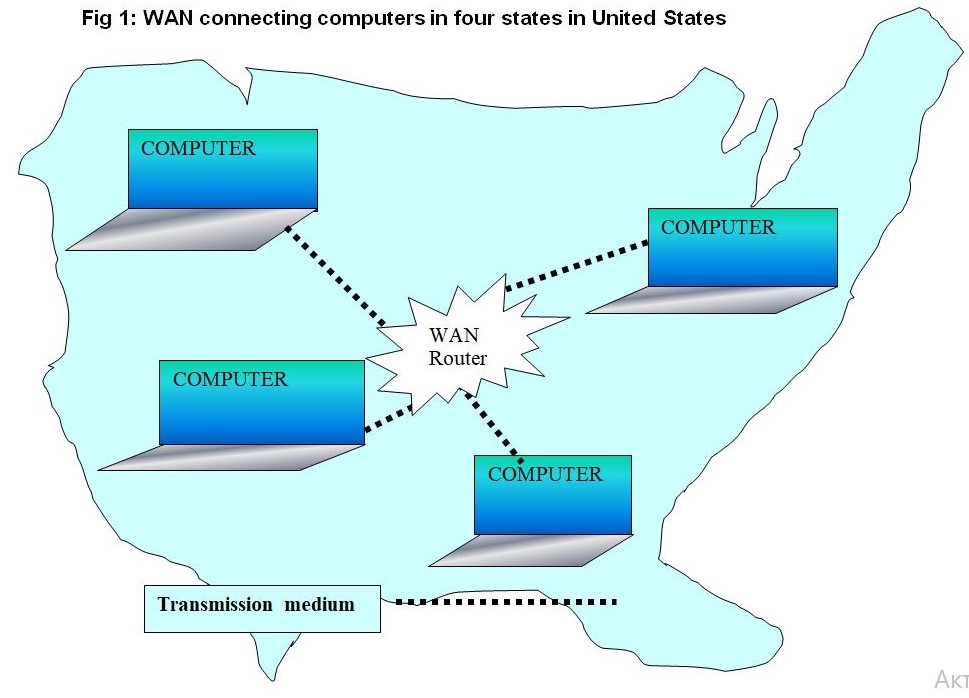
Since our employees will make constant long distance phone calls, we aim to achieve cost effective by using WAN for a telecommunications network over a large geographical region. With WAN technology, it will be very easy to route phone call and fax transmission over voice-over-IP (VOIP) technology over the same network. The main advantage of WAN is that our call centers will be able to reduce phone bills because the communication links will convert voice to IP packets, and there will be no separate phone bills for each location.
By using WAN for VOIP phone call, the four locations will be able to merge voice with video and data communication over company data’s network. (George Reynolds, 2007). Moreover, Integrating database system into WAN will enhance communication system where every team member in the four locations will be informed about the company activities, and this will make our employees to have access to information anytime with WAN support.(TCO systems).
However, designing network involves critical analysis of network topology as discussed in next section.
Analysis
Existing networks in Chicago could not support requirements of our call center because Chicago headquarter is currently using an IBM 9000 Series Mainframe that has become outdated, and cannot support the management needs. There is also issue of transmission of data from one location to the other, the existing network lacks this feature, moreover, network in Chicago is rather slow, and cannot improve quality of service (QoS). With all the problems confronting our call center, the next section provides recommended solution.
Recommend Solution – System Design
The system that can support our call center’s needs is Local Area Network (LAN) and Wide Area Network (WAN). WAN network will be suitable for management needs because WAN can support different geographical locations with over 500 kilometres. Typically, the network systems that can support the needs of our call centers should have capacity to able to monitor 50 employees and 20 mobile users with wireless access. In addition, the network systems should be able to connect all four sites with redundancy, a databases that will support the 24/7 365 day operations, and deployment of a wireless network at each site. There network system should included VOiP at each site to monitor control that is redundant.
Typically, WAN can cover multiple distances, and can connect multiple smaller networks such as local area networks (LAN). WAN technology can function at the physical layer, the data link layer, and the network layer. Key technologies often found in WANs include ATM, SONET, Frame Relay, X.25, ATM and Point-to-point (PPP). (Edraw Soft, 2009)
Apart from WAN to connect the four locations, each of the location will require local area network (LAN) to connect terminals, computers and printers within a building office, and the devise to adopt this is to connect network through wireless links. It should be noted that standard LAN come with technologies such as Ethernet, Token Ring and Wireless LAN using IEEE 802.11. (Edraw Soft, 2009). However, these networks need some requirements before it can fit our call centers’ needs.
Thus, to offer proposed network for Chicago office, there is need to examine the existing network in Chicago office.
Existing Chicago Headquarters Network
The existing Chicago network of our call center was originally designed to facilitate communication in the Chicago office. However, with increase in the number of employees and customers, this network can no more support the company facility because of the plan for credit card protection and registration. Although, our call center has tried to improve network system in the past by adding network routers and token ring to LANs. All these solutions could not provide management needs. Existing network for Chicago location consist of six Cisco 2613 routers, the network routers are linked to the IBM9000 Mainframe utilizing 100BASE-T4 transmission media. Distributed to the seven Cisco 2613 routers are four Server Farm 16mbps Token-rings with 6 AS/400’s per ring, and 6 16mbps Token-ring end user LANs. Although, there are internet connection filtering for inbound network traffic and provision of a simple De-Militarized Zone (DMZ) for the corporate external mail server. The Internet router is networked to one of the Cisco 2613 backbone routers with a 100BASE-T4 connection. Fig 2 provides visual presentation of existing Chicago network.
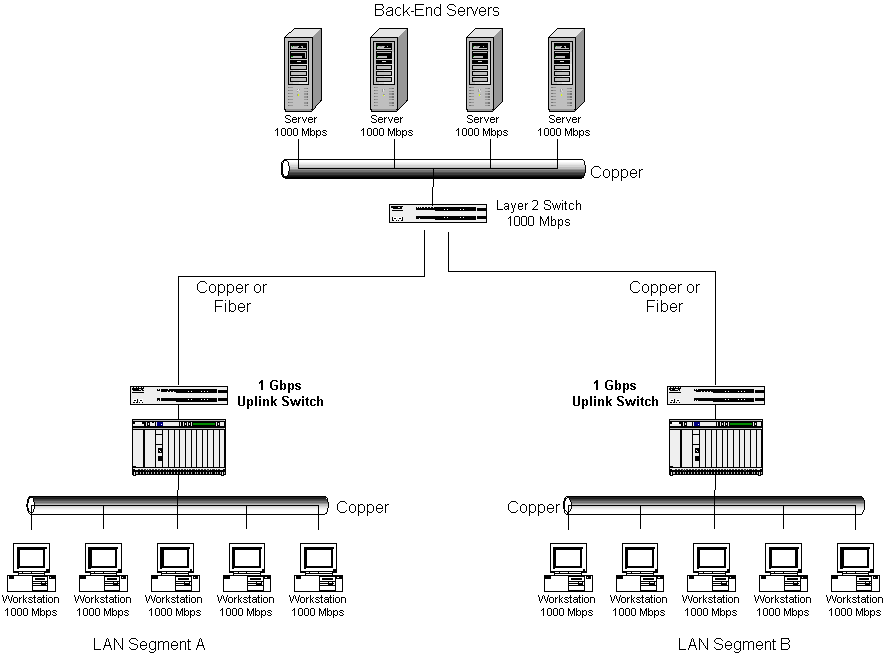
Proposed Chicago Network Diagram including new Wireless implementation to new sites
The redesigned Chicago network will be similar to old Chicago network to increase the capacity of the existing network; there will be augmentation of the infrastructure of existing network in order to increase its bandwidth. There will also be installation of Cisco 7507’s to provide higher densities that can provide greater performances along with encryption support for network security. The change in bandwidth will provide increase in the transmission speeds for the AS400 is from 16Mbps to 100Mbps.Fig 3 reveals a visual presentation of a proposed Chicago network. The network will involve placing Network Interface Card into personal computers, and there will be connections of computers through wireless network, where all computers in our call center will be connected through communication channels. (BICSI, 1996, Murhammer, 1999). Typically, the type of network bandwidth that will be installed in Chicago headquarter will enhance communication system at new sites. However, to reduce cost, management will connect Dallas, Denver, and Atlanta through public networks with Cisco 7507 routers. By using public network, management can lease communication equipment from a network service provider. Using a third party network service provider can be cost effective because a public service provider charge relative low cost for connecting different geographical locations. Proposed network also offers additional features of relational database in the network system, and the database will be able to store large amount of data with WAN acceleration. In addition, database system will offer credit card registration for customers as well as credit card transactions. The proposed network system in Chicago will help our call center to monitor support 24 / 365, as well as offering online Analytical Processing (OLAP) with speed and accuracy. (KEMME, ALONSO, 2000).
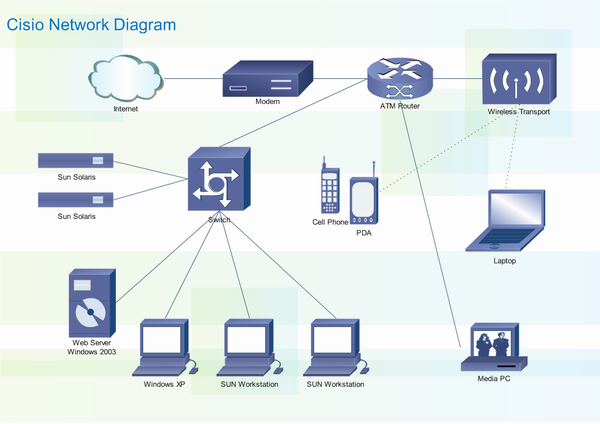
Proposed Dallas Network
The proposed Dallas network will be designed from the beginning to allow for seamless network integration, load balancing, redundancy, and ease management use. A diagram in fig 4 provides visual presentation of the proposed network. The Chicago network will connect Dallas network with Cisco 7507 Router. Typically, the router will be configured with 100BASE-FX connection, and there will be LAN segment connected to the local Cisco 5500 Catalyst switch. There will also be installation of firewall for corporate security regarding internet connectivity. Typically, proposed Dallas Network will be connected to internet using a local ISP (Internet Service Provider) T1 connection for internet e-mail, ftp and WEB connectivity, and network will provide substantial bandwidth and transmission speeds to allow future growth, redundancy, and easy expandability. Finally, a robust Network Management System with disaster recovery will be selected to monitor and ensure network reliability.
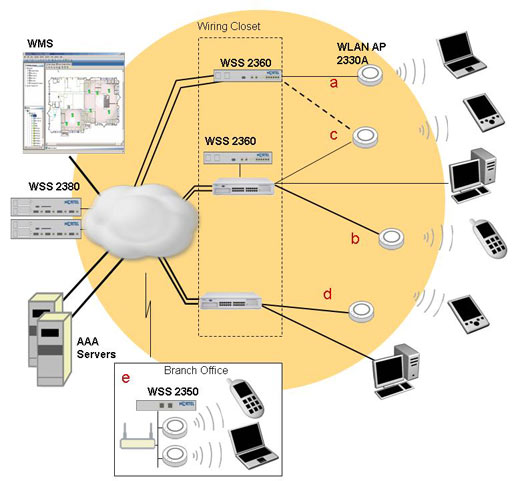
Proposed Denver Network
The design for Denver network will consist of seamless network integration of 802.1x IEEE 802.1x port-based network access control standard. The advantage of 802.1x is the ability to provide encryption, and 802.1x will allow WAPs and clients to share and exchange WEP encryption keys automatically. (Tech Republic, 2006).
For the enhancement of corporate security, there will be installation of firewall to provide security during data transmission. The proposed Denver will use a local ISP (Internet Service Provider) T1 connection for internet e-mail, ftp and WEB connectivity. Fig 5 provides visual presentation of proposed Denver network.
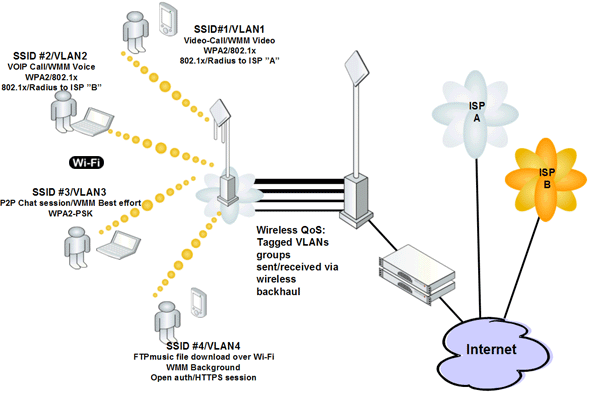
Proposed Atlanta network
The system network design proposed for Atlanta network will consist of IEEE 802.11a physical layer (PHY), which is an interface between medium access controls. The 802.11a has the capacity of to transmit frames at multiple rates of up to 54 Mbps), its capacity will enhance multimedia transmissions over WLAN networks. See fig 6 for visual illustration of network design. (Troychak, 2002). For the enhancement of security, there will be installation of firewall to protect network from non-trusted network. Typically, protection is essential to prevent a malicious individual to get access into network through third party network, and for adequate protection, installation of Firewalls software can provide adequate protection to network, database, and overall credit card protection.
Moreover, there will be an installation of cryptography technology in order to encrypt all information transmitted during data transmission. This is to ensure that sensitive information do not get into the hand of an unauthorized person.
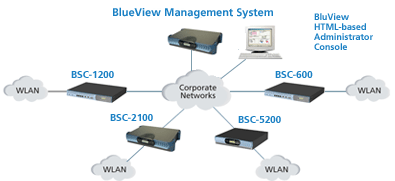
Transition Plans
There are currently 300 employees at Support center located at Chicago headquarter, 60 have expressed interest to relocate to Dallas to support new operation, 50 employees have also wanted to relocate to Atlanta new location while 40 have decided to move to Denver new location. (See Table 1).
There is indication that there will be increase in the numbers of network users by 6-12% each year, and most of this growth is projected to occur in Chicago, Dallas, and Atlanta operation centers.
Table 1: The following table depicts the planned personnel movement and growth projections.
There will also be relocation of server farm which begin May 1st and complete by December 31st. This relocation strategy is to ensure that there is no engineering disruption with the AS/400 servers, as well as providing for AS/400 disaster recovery between among the four locations. Thus, the overall critical success is that personnel and equipments are relocated with minimal problems.
WAN Connectivity and Design
The WAN connectivity will be through Asynchronous Transfer Mode (ATM) connection with a data rate of 155 Mbps. For speedy transmission, there is need for fast high-end, multimedia transmissions with ATM. Typically, ATM provides scalability, flexible bandwidth allocation, high bandwidth utilization, and quality of service guarantees. Minimization of fault needs a connection of each ATM by opposite sides of each building. Management of WAN will be based on Simple Network Management Protocol (SNMP) to allow integration with third party tools.
Backup Strategy
All servers in Chicago and servers to be relocated to Denver, Atlanta, and Dallas, and LAN server in these locations will undergo a complete tape backup process nightly. Tapes are rotated off-site for disaster recovery purposes, and there will be server space to store critical data.
Network Security Plan
Although, Firewall is proposed for the provision of adequate security for the networks, nevertheless, there will also be provision for information security department at each of the four locations. In addition, there is need to procure security specialist for the provision of adequate security for network. AT&T Solutions can perform this important task.
Business Continuity Plan
There is need to develop detailed Disaster Recovery Plans for Chicago, Dallas Atlanta, and Denver based on the fact that current team are ignorant of the disaster recovery for the networks. There is need to procure specialist for this project. AT&T Solutions can perform this important task.
Implementation Plan
Implementation Overview
The network implementation Plan for all our call centers will start from May 1 2010, and a completion date will be April 1, 2011. Changes that may lead to interruption of network service will be minimized and only implemented during weekends as permitted by operational commitments.
Proposed Implementation Plan
Preliminary Activities
Engage AT&T Solutions (4 weeks)
Information Security risk assessment
Information Security Policy creation
Business Continuity Plan
Procure all network hardware and software: routers, firewalls, workstations, servers, cable, and anti-virus. (4 weeks)
Dallas, Denver, and Atlanta LAN Upgrade
Replace the seven Cisco 2613 backbone routers with two Cisco 7507’s and configure accordingly. (4 days)
Install and configure Cisco Catalysts 5500 Switch. (1 week)
Install and configure two Cisco Multiplexers (3 days)
Configure end user LANs and workstations (4 weeks)
Create the videoconferencing network segment and deploy the associated equipment. (4 days)
Implement the new Internet DMZ architecture. (1 week)
Reconfigure two Cisco 2613’s as screening routers.
Install the Rapid Stream Firewall appliances.
Create new secure DMZ with web server and external mail server
Configure firewall rules
Chicago LAN Implementation
Install two Cisco 7505 backbone routers and configure accordingly. (4 days)
Install and configure Cisco Catalysts 5500 Switch. (1 week)
Establish the routed (data) network (4 weeks)
Install network equipment (routers, switches, workstations, and servers)
Configure end user LANs and workstations (4 weeks)
Create the videoconferencing network segment and deploy the associated equipment. (4 days)
WAN Implementation
- Establish communication links among Chicago, Dallas, Denver, and Atlanta (3 weeks)
- Establish Network Management System (3 weeks)
- Install software
- Network Management Operations training Network Documentation
- Update network diagrams (1 week)
- Update existing Dallas network diagram to reflect implemented changes
- Create new California network diagram to reflect new network
- Create WAN overview diagram to reflect site interconnection and service provider information
System Testing
- Test Network (1 week)
- Conduct point-to-point connectivity checks
- Conduct end-to-end connectivity checks
- Test data flow using transaction generators
References
Aron, J, 2007), Using WAN Acceleration to Improve SQL Performance, Management and Protection, Info Management Direct.
BICSI, (1996), LAN Design Manual – CD-ROM, Issue 1
Cisco system, (2006), IPsec VPN WAN Design Overview, Cisco Systems, Inc.
Cisco, (2009), Introduction to WAN Technologies, Internetworking Technology Handbook, Cisco Systems, Inc
Edraw Soft, (2009), Wide Area Network Technologies Overview, Edraw Soft.
Hellerstein, J, M, Stonebraker, M, Hamilton, J, (2007), Architecture of a Database System, Foundations and Trends in Databases, Vol. 1, No. 2 pp 141–259.
Hekmat, S, (2007), Communication Networks, Pragsoft.
Hewlett Packard, (2006), WAN Design Guide The Lower Layers, Procure Networking by HP.
Karygiannis, T, Owens,L, (2002), Wireless Network Security 802.11, Bluetooth and Handheld Devices, National Institute of Standards, and Technology, Special Publication 800-48.
MC technologies, LANPORT WAN ROUTER, MC TECHNOLOGIES GMBH
Michell, B, (2009), Router.
Murhammer M, W, et al, (1999), IP Network Design Guide, IBM Corporation, International Technical Support Organization, International Business Machine.
Kemme, B, Alonso, G, (2000), A New Approach to Developing and Implementing Eager Database Replication Protocols, ACM Transactions on Database Systems, Vol. 25, No. 3, pp 333–379.
Stair, R, Reynolds, G, (2007), Fundamental to Information systems, Course Technology; 4 edition.
TCO systems, TCO Systems Team Communication and Organization.
Tech Republic, (2006), Wireless LAN Design, Cisco Press.
Troychak, J, (2002), Design and Verification of IEEE 802.11a 5 GHz Wireless LAN Systems, Agilent EEsof EDA.